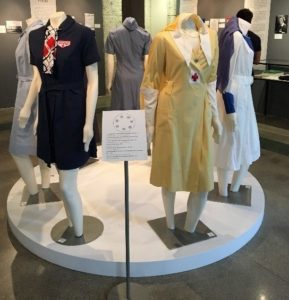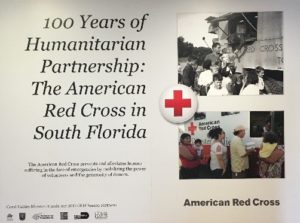Coral Gables Museum Exhibit: Feb. 2 to May 27, 2018
In February of 2018, the Coral Gables Museum in Coral Gables, Florida opened the exhibit 100 Years of Humanitarian Partnership: The American Red Cross in South Florida. The museum generously provided gallery space and staff time to research and mount the exhibit. Using artifacts, uniforms, photographs, and compelling stories, the museum conveyed the story of the Red Cross in South Florida for the past 100 years. As part of this cooperative community effort, the Miami Chapter of the Red Cross hosted a lunch and learn, and I was honored to be the guest speaker for this event.
Uniforms Showcased in the Exhibit



Red Cross History in South Florida
The Miami Chapter like many other Red Cross chapters received their official charter when the United States entered World War I in April of 1917. Although World War I was a watershed time for Red Cross chapter formation, the history of Red Cross activity in South Florida starts much earlier. In 1898 Clara Barton, founder of the American Red Cross, sailed with 20 volunteers to Cuba from the Florida Keys on a ship loaded with supplies to provide relief for the military and refugees. Many of these supplies came from the West Palm Beach area of Florida. Barton’s journey to Cuba was the first official recognition by the U.S. government of the legal status of the American Red Cross under the Treaty of Geneva.
Through the World War I and World War II years, the state’s population grew as did the presence of the Red Cross. World War I witnessed chapter formation and development which played a pivotal role in the 1920s with the response to at least two damaging hurricanes. The first one occurred in 1926 and the second one was in 1928. The residents of Florida witnessed devastating property losses in 1926 and large numbers of casualties in 1928.
The exhibit also focuses on watershed periods for the Red Cross and the region. In World War II the state’s population growth exploded and military bases expanded rapidly. Florida provided an excellent training ground with its year-round temperate climate and the coastline found its place in the war’s history with German submarines sinking US ships off the coast—some in sight of the beach. In the Palm Beach and Miami areas, luxury resorts were turned into military housing and hospitals for the growing numbers of service members.
Throughout the post-World War II boom to the late 20th century and beyond, the region’s population has grown into the millions and the Red Cross has continued to change and meet the needs of the ever expanding and diverse population, bringing hope and help to South Florida for the past 100 years.
To learn more, visit the exhibit at the Coral Gables Museum before it ends on Sunday, May 27.


